In today’s health-conscious world, protein is an essential macronutrient that often steals the spotlight. It plays a vital role in building and repairing tissues, creating enzymes and hormones, and supporting immune function. But if you follow a vegetarian lifestyle, you might wonder, “How can I efficiently boost my protein intake?” In this article, we’ll explore easy vegetarian recipes that not only enhance your protein consumption but also excite your taste buds.
Why Is Protein Important?
Before diving into sumptuous recipes, let’s briefly understand why protein is essential:
- Muscle Building: Protein helps repair and build muscle tissues, which is crucial whether you’re working out or simply going through your daily activities.
- Satiety: A high-protein diet can help you feel fuller for longer, aiding in weight management.
- Energy Boost: Protein contributes to energy production, ensuring you stay active throughout the day.
How Much Protein Do You Need?
The recommended dietary allowance (RDA) for protein is about 46 grams per day for women and 56 grams for men. However, individual needs may vary based on factors like age, activity level, and fitness goals. If you’re active or looking to increase muscle mass, you may require more.
Ideal Vegetarian Protein Sources
Here are some excellent vegetarian sources packed with protein:
- Legumes: Lentils, chickpeas, and black beans.
- Quinoa: A complete protein grain.
- Nuts and Seeds: Almonds, chia seeds, and hemp seeds.
- Dairy: Greek yogurt and cottage cheese (if you’re lacto-vegetarian).
- Eggs: A great protein source for ovo-vegetarians.
Easy Vegetarian Recipes to Boost Your Protein Intake
1. Lentil and Quinoa Salad
Ingredients:
- 1 cup cooked lentils
- 1 cup quinoa, cooked
- 1 bell pepper, diced
- 1 cucumber, diced
- ½ cup cherry tomatoes, halved
- Olive oil, lemon juice, salt, and pepper to taste
Instructions:
- In a large bowl, combine the lentils and quinoa.
- Add the diced vegetables.
- Drizzle with olive oil and lemon juice, then season with salt and pepper.
- Toss everything gently and serve chilled or at room temperature.
2. Chickpea Stir-Fry
Ingredients:
- 1 can of chickpeas, rinsed and drained
- 2 cups mixed vegetables (broccoli, bell peppers, carrots)
- 2 tablespoons soy sauce
- 1 tablespoon olive oil
- Cooked brown rice or quinoa to serve
Instructions:
- Heat the olive oil in a large pan over medium heat.
- Add the mixed vegetables and stir-fry for about 5 minutes.
- Stir in the chickpeas and soy sauce. Cook for another 3-5 minutes until everything is heated through.
- Serve hot over brown rice or quinoa.
3. High-Protein Smoothie
Ingredients:
- 1 cup almond milk
- 1 banana
- 2 tablespoons peanut butter
- 1 scoop plant-based protein powder (optional)
- 1 tablespoon chia seeds
Instructions:
- Combine all ingredients in a blender.
- Blend until smooth.
- Pour into a glass and enjoy a protein-packed breakfast or snack!
4. Greek Yogurt Parfait
Ingredients:
- 1 cup Greek yogurt
- ½ cup granola
- 1 cup mixed berries
- Drizzle of honey (optional)
Instructions:
- In a glass or bowl, layer Greek yogurt, granola, and mixed berries.
- Repeat the layers until all ingredients are used.
- Drizzle honey on top for added sweetness.
5. Black Bean and Sweet Potato Tacos
Ingredients:
- 1 can black beans, rinsed and drained
- 1 medium sweet potato, cubed and roasted
- Corn tortillas
- Avocado, salsa, and cilantro for topping
Instructions:
- Roast cubed sweet potatoes in the oven at 400°F (200°C) for about 20 minutes until tender.
- Warm the black beans in a pan.
- Assemble the tacos by layering sweet potatoes, black beans, and your choice of toppings on corn tortillas.
Tips to Increase Your Vegetarian Protein Intake
- Snack Wisely: Choose protein-rich snacks like nuts, seeds, or Greek yogurt.
- Incorporate Variety: Combine different protein sources, such as legumes and grains, to optimize protein quality.
- Plan Your Meals: Prepping meals in advance helps you include protein in each dish.
Conclusion
Boosting your protein intake as a vegetarian doesn’t have to be complicated. With these easy recipes and a little planning, you can enjoy a varied diet that meets your protein needs while tantalizing your taste buds. Whether you’re a seasoned vegetarian or new to the lifestyle, incorporating these nutritious and delicious meals can make a significant difference in your overall health.
Remember, your body needs protein for many essential functions, so make sure to include it in your daily meals. Happy cooking!









 Weight Loss, Unlocked.
Weight Loss, Unlocked.